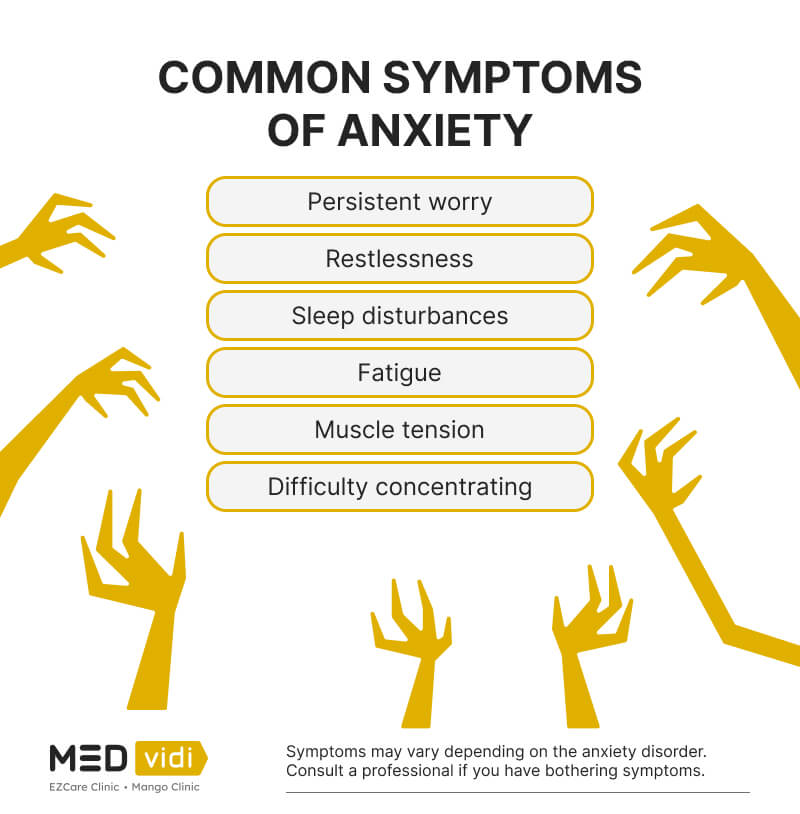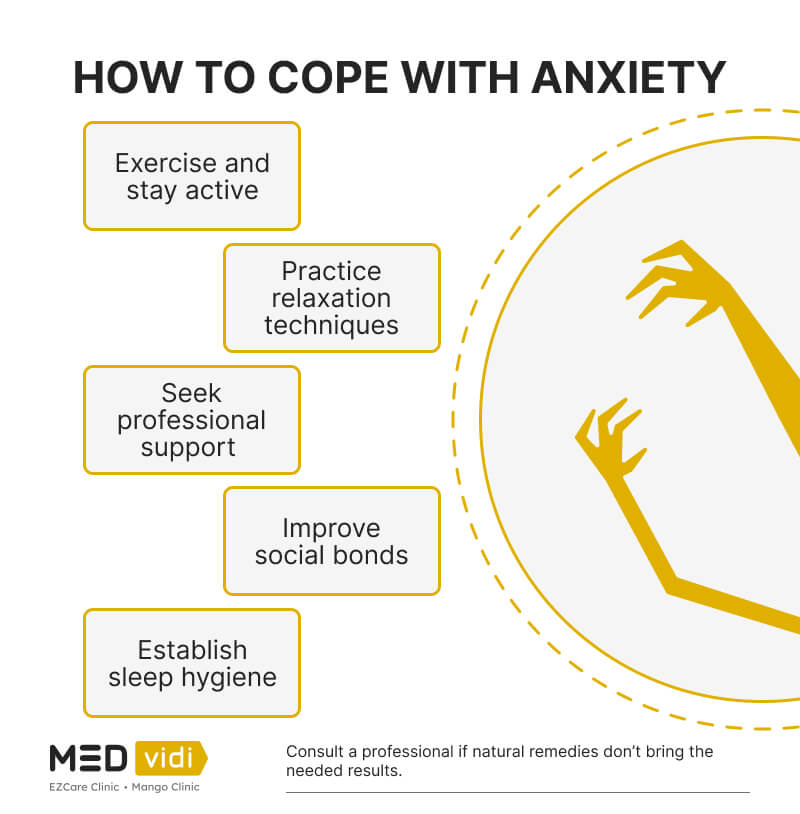Anxiety disorders are complex mental health conditions characterized by excessive worry, fear, nervousness, and unease, often leading to physical and emotional distress. The prevalence of anxiety disorders has surged during the last 30 years, now impacting over 300 million lives across the globe. However, treatment of anxiety disorders is not an insurmountable task. Due to the variety of available medications, psychotherapy approaches, and other strategies, you can regain control of your life and experience a newfound sense of peace.
This article aims to provide an in-depth guide to anxiety disorders. It includes an overview of their types, symptoms, treatment options, and self-help techniques.
Ease anxiety symptoms with the help of a certified mental health specialist. Schedule an online visit today!
What is an Anxiety Disorder?
An anxiety disorder is a mental health condition characterized by excessive and persistent feelings of fear, worry, or unease. Unlike normal feelings of stress or occasional anxiety, which everyone experiences, anxiety disorders involve intense and prolonged symptoms that go beyond what is considered typical or appropriate in a given situation. There are several types of anxiety disorders, and each of them can significantly interfere with your daily life and functioning.
Types of Anxiety Disorders
Aside from the commonly known generalized anxiety disorder (GAD), there are also other types of anxiety. They differ in specific symptoms, causes, and triggers. Below, let’s review the types and symptoms of anxiety disorders in detail.
Generalized Anxiety Disorder (GAD)
Generalized anxiety disorder causes persistent worry and fear about work, family, health, finances, or everyday situations. The worry is often disproportionate to the actual circumstances, and individuals find it difficult to control or suppress their anxious thoughts. GAD can interfere significantly with daily life, making it hard for people to focus on tasks, relax, or get restorative sleep. Other symptoms include the following:
- Restlessness and irritability. Feeling on edge, restless, or easily agitated; finding it challenging to relax.
- Muscle tension. Experiencing muscle tension or tightness, leading to physical discomfort or pain.
- Fatigue. Feeling persistently tired and drained due to the energy-consuming worry and anxiety.
- Sleep disturbances. Having trouble falling asleep or staying asleep due to racing thoughts or worries.
- Difficulty concentrating. Finding it hard to focus or experiencing a mind going blank due to preoccupation with anxious thoughts.
- Physical symptoms. Headaches and stomachaches.
Panic Disorder
Panic disorder is a chronic anxiety disorder in which individuals experience recurrent panic attacks. A panic attack is a sudden and intense episode of fear or discomfort that can reach its peak within minutes. It makes people feel like they are experiencing a life-threatening situation, even when there is no apparent danger. The fear of experiencing a panic attack or anxiety attack can lead to anticipatory anxiety, where individuals become anxious about the possibility of having future attacks.
In addition to fear or a feeling of impending doom, panic attacks are accompanied by physical symptoms, such as:
- Palpitations or racing heartbeat. A feeling of the heart pounding or racing, leading to increased anxiety.
- Chills or hot flashes. Experiencing sudden changes in body temperature.
- Sweating, often unrelated to physical exertion or temperature.
- Shaking. Involuntary shaking or trembling of the body.
- Chest pain or discomfort. Sharp or aching pain in the chest, sometimes mistaken for a heart attack.
- Shortness of breath. Difficulty breathing, accompanied by a sense of choking or suffocation, or sensation of the throat closing up.
- Nausea. Upset stomach, nausea, or abdominal discomfort.
- Dizziness or lightheadedness. Feeling faint or unsteady, as if about to lose consciousness.
Social Anxiety Disorder
Social anxiety disorder is associated with worries centered around social situations and interactions. Individuals with this disorder have an excessive fear of being judged, embarrassed, or humiliated in social settings. They often worry intensely about being perceived negatively or making mistakes, leading to feelings of inadequacy and low self-esteem. The fear and anxiety caused by social anxiety disorder can be so severe that it hinders a person’s ability to engage in social activities, work, or school, impacting their overall quality of life. Common symptoms include the following:
- Excessive worry. Persistent and excessive worry before, during, or after social events.
- Fear of embarrassment. An overwhelming fear of embarrassing oneself in front of others.
- Blushing. Feeling flushed or experiencing facial redness in social situations.
- Sweating. Profuse sweating, particularly in the hands, underarms, or face.
- Trembling or shaking. Involuntary trembling or shaking, often noticeable to others.
- Rapid heartbeat. Palpitations or a racing heart in social situations.
- Nausea or stomach upset. Upset stomach or nausea before or during social interactions.
- Mind going blank. Difficulty concentrating or feeling like the mind is going blank during conversations.
- Muscle tension. Experiencing tense muscles or physical discomfort in social settings.
- Avoidance. Avoiding social situations, which may interfere with work, school, or personal relationships.
Specific Phobias
Specific phobias are a common type of anxiety disorder characterized by an intense and irrational fear. Unlike other anxiety disorders, individuals with specific phobias experience an overwhelming fear that is triggered by a particular stimulus: specific objects, situations, or activities. The fear is typically disproportionate to the actual danger posed by the phobic stimulus. Specific phobias can significantly impact a person’s daily life, leading to avoidance behavior and interference with work, school, and personal relationships.
Common phobias include fear of heights (acrophobia), spiders (arachnophobia), flying (aviophobia), enclosed spaces (claustrophobia), and public speaking (glossophobia), among many others. While stimuli vary, many symptoms are similar in different phobias. They include:
- Excessive fear and anxiety neurosis. An intense and immediate feeling of fear or panic when exposed to the phobic stimulus.
- Avoidance. Going to great lengths to avoid the phobic trigger, which may interfere with everyday life.
- Rapid heartbeat. Palpitations or a racing heart when encountering the phobic stimulus.
- Sweating and trembling. Profuse sweating and involuntary trembling in response to the phobia.
- Shortness of breath. Difficulty breathing or feeling like one cannot catch their breath.
- Nausea or upset stomach. Experiencing stomach discomfort or nausea in the presence of the phobic trigger.
- Feeling faint or dizzy. The sensation of lightheadedness or feeling faint when exposed to the stimulus.
Agoraphobia
Agoraphobia is more than a fear of open spaces. It can make a person feel trapped and helpless in specific places. Agoraphobia can be a consequence of panic disorder, where people begin to fear having panic attacks in public or unfamiliar places because they are afraid of being unable to escape or get help. People with this disorder often avoid certain environments or situations, leading to a sense of confinement and isolation.
Common symptoms of agoraphobia include:
- Panic attacks. Fear of experiencing panic attacks in specific situations is a hallmark of agoraphobia.
- Avoidance behavior. Avoiding certain places or situations that provoke anxiety, often leading to a limited and restricted lifestyle.
- Anxiety and fear. Feeling anxious or fearful when contemplating exposure to agoraphobic situations.
- Physical symptoms. Panic attacks or anticipatory anxiety may lead to physical symptoms like rapid heartbeat, sweating, trembling, shortness of breath, chest pain, or nausea.
- Feeling trapped. Sensations of being trapped, helpless, or unable to escape.
Separation Anxiety
Separation anxiety is an emotional response that occurs when a child is separated from a parent or caregiver with whom they have formed a strong bond. It is a normal developmental phase experienced by most children, usually peaking between 8 months and 3 years of age. During this period, children may become upset or distressed when separated from their primary attachment figure, but as they grow older and develop a sense of object permanence, these feelings typically diminish. While it is normal for children to experience some level of separation anxiety during early development, in cases of separation anxiety disorder, these emotions and behaviors become excessive, persistent, and disruptive to the child’s daily life.
The symptoms of separation anxiety include the next:
- Fear of separation. Expressing fear or worry about being separated from the caregiver.
- Crying or screaming. Excessive crying or screaming when separated from the caregiver.
- Clinging. Persistent clinging to the caregiver and not wanting to let go.
- Refusal to go to school. Reluctance or refusal to attend school or daycare due to separation anxiety.
- Nightmares. Having distressing dreams or nightmares about separation.
- Physical symptoms. Complaining of physical symptoms like stomachaches or headaches when separation is imminent.
Selective Mutism
Selective mutism is a complex anxiety disorder that typically emerges during early childhood when children are learning to navigate social interactions. It is characterized by a consistent failure to speak in specific social situations, despite being able to speak in other settings. Children with selective mutism may demonstrate normal language and communication skills at home or with close family members but remain silent or use minimal speech when faced with unfamiliar people or social environments. If left untreated, the condition may remain in adolescence and adulthood.
Selective mutism is not merely a child’s refusal to speak; it is an anxiety-based communication disorder. Although the child may be fully capable of speech and language development, they experience extreme anxiety or discomfort when expected to speak in specific settings, such as school, social gatherings, or public places. The symptoms include the following:
- Persistent silence. Refusal to speak or minimal speech in certain social settings, especially with unfamiliar people or in larger groups.
- Social withdrawal. Avoiding social interactions or becoming socially withdrawn in situations where speaking is expected.
- Anxiety and tension. Displaying signs of anxiety or tension, such as fidgeting, blushing, or trembling, when confronted with the need to speak.
- Limited eye contact. Avoiding eye contact or looking down to avoid interacting with others.
- Reluctance to participate. Avoiding or being reluctant to participate in group activities or answering questions in class.
- Limited initiating of communication. Displaying hesitation or difficulty in initiating communication with peers or adults.

Medication-induced Anxiety Disorder
Medication-induced anxiety disorder occurs when the use of certain medications or substances triggers anxiety symptoms. These symptoms may be temporary and subside after discontinuing the medication or substance. But in some cases, they can persist or worsen. The disorder is categorized as a substance/medication-induced mental disorder in the Diagnostic and Statistical Manual of Mental Disorders (DSM-5). The symptoms may include:
- Excessive worry. Persistent and excessive worry about various aspects of life.
- Restlessness. Feeling restless or on edge most of the time.
- Difficulty concentrating. Finding it challenging to focus or experiencing a mind going blank.
- Physical symptoms. Anxiety symptoms may also manifest as physical symptoms, including rapid heartbeat, sweating, trembling, shortness of breath, dizziness, or stomach upset.
- Sleep disturbances. Difficulty falling asleep or staying asleep due to racing thoughts or anxiety.
- Panic attacks. In some cases, certain medications or substances may trigger panic attacks.
Causes of Anxiety Disorders
While the exact etiology of anxiety disorders remains multifaceted and not fully understood, there are some contributing factors:
- Environmental stressors. Chronic exposure to stress and traumatic life events can trigger anxiety disorders. Experiences like physical or emotional abuse, neglect, accidents, the loss of a loved one, and other stressful situations can have a lasting impact on an individual’s mental health. Prolonged stress can alter brain functioning and exacerbate anxiety symptoms, making individuals more susceptible to developing a disorder.
- Brain structure and function. Brain imaging
studies [1*] have provided insights into the physical aspects of anxiety disorders. The amygdala, a region responsible for processing emotions, plays a significant role in anxiety. Individuals with anxiety disorders often exhibit an overactive amygdala, leading to exaggerated fear responses. Additionally, the prefrontal cortex, responsible for rational thinking and decision-making, may function differently in those with anxiety disorders, impacting their ability to control anxious thoughts and behaviors.
If anxiety worsens your life quality, consider seeking professional medical advice.
Risk Factors for Anxiety Disorders
While anxiety disorders can develop in anyone, certain risk factors can increase the likelihood of their occurrence. Recognizing these factors can help with early identification, prevention, and effective management of anxiety disorders:
- Family history. Individuals with a family history of anxiety disorders are at a higher risk of experiencing similar conditions. Genetic factors may predispose people to be more susceptible to anxiety, as certain genes can influence how the brain responds to stress and fear. However, having a family history of anxiety does not guarantee that someone will develop an anxiety disorder, as environmental factors also play an important role.
- Early life experiences. Childhood experiences can shape a person’s emotional and mental well-being, and adverse experiences during early development can be significant risk factors for anxiety disorders. Traumatic events, abuse, neglect, or witnessing violence can have a lasting impact on a child’s psyche and increase their vulnerability to anxiety later in life. Early exposure to chronic stress or chaotic family environments can also contribute to the development of anxiety disorders.
- Neurobiological factors. Anxiety disorders are associated with changes in brain chemistry and functioning. Imbalances in neurotransmitters, such as serotonin, dopamine, and norepinephrine, can influence mood regulation and anxiety levels. Additionally, parts of the brain involved in the fear response, such as the amygdala and the prefrontal cortex, may be hyperactive in individuals with anxiety disorders, contributing to heightened anxiety and fear.
- Personality traits. Certain personality traits can increase the risk of developing anxiety disorders. People with an inherently anxious temperament, characterized by traits like neuroticism or emotional instability, may be more prone to experiencing anxiety in response to stressors. Perfectionism, excessive worry, and a tendency to catastrophize or overthink situations can also contribute to the development of anxiety disorders.
- Chronic stress. Prolonged exposure to stress can take a toll on a person’s mental health, increasing the risk of anxiety disorders. Stressful life events, such as financial difficulties, job loss, relationship problems, or chronic illness, can trigger or exacerbate anxiety symptoms. The body’s stress response system, which involves the release of stress hormones like cortisol, can become dysregulated in response to chronic stress, leading to increased anxiety and vulnerability to anxiety disorders.
- Substance abuse. Substance abuse and addiction are closely linked to anxiety disorders. Drugs and alcohol can temporarily alleviate anxiety symptoms, leading some individuals to self-medicate their anxiety. However, long-term substance use can worsen anxiety or increase the risk of developing an anxiety disorder. Substance-induced anxiety disorder is a recognized mental health condition caused by the use of certain medications or substances.
- Chronic medical conditions. Certain chronic medical conditions, such as chronic pain, cardiovascular disease, or respiratory conditions, can be risk factors for anxiety disorders. Dealing with the physical limitations and uncertainty associated with chronic illnesses can trigger or exacerbate anxiety symptoms.
How Common are Anxiety Disorders?
According to the World Health Organization (
- Generalized anxiety disorder (GAD) is estimated to affect around 4% of the global population.
- Social anxiety disorder (social phobia) is estimated to affect
about 12% [3*] of US adults at some period of their lives. - Panic disorder affects
4.7% [4*] of US adults. - Specific phobias are estimated to affect around
3-15% of the population [5*] .
Diagnosing Anxiety Disorders
Diagnosing anxiety disorders is a comprehensive process that includes a thorough evaluation of symptoms and ruling out other potential conditions. The steps are the following:
- Clinical interview. A psychiatrist, psychologist, or another healthcare professional begins with a comprehensive clinical interview. It helps to assess a patient’s symptoms, medical history, personal background, family history, and any relevant stressors. Open and honest communication is essential to ensure an accurate evaluation.
- Symptom assessment. Mental health professionals assess anxiety symptoms based on standardized criteria outlined in the Diagnostic and Statistical Manual of Mental Disorders (DSM-5). The DSM-5 provides a structured framework for identifying and diagnosing mental health conditions. Symptoms are evaluated for their duration, severity, and impact on the individual’s daily life.
- Differentiating from other conditions. Some other medical or psychological conditions may have symptoms similar to anxiety disorders. These include hormonal imbalances, heart issues, sleep apnea, and others.
- Subtype identification. Different types of anxiety disorders have distinct characteristics. Identifying the specific subtype helps to establish an appropriate treatment plan. For instance, social anxiety disorder may require different interventions than generalized anxiety disorder.
Unlike some medical conditions, anxiety disorders do not have definitive laboratory tests or imaging procedures for diagnosis. However, specific tests may support the diagnostic process:
- Self-report questionnaires. Various self-report questionnaires, such as the Generalized Anxiety Disorder-7 (GAD-7) or the Social Phobia Inventory (
SPIN [6*] ), may be used to assess anxiety symptoms and severity. - Physical examination. A physical examination helps rule out medical conditions that may contribute to or resemble anxiety symptoms.
- Blood tests. Blood tests may be conducted to assess thyroid function and vitamin levels or identify other factors that may influence anxiety.
- Psychological assessments. Psychological assessments, including structured interviews and standardized measures, help mental health professionals gain a deeper understanding of the individual’s emotional and cognitive functioning.
Note that self-diagnosis with questionnaires is not legit. Only a healthcare professional can diagnose anxiety disorders after at least one consultation.

Management and Treatment Methods
While anxiety is a natural human response, excessive and persistent anxiety can be distressing and impair daily functioning. Fortunately, there are effective management and treatment methods. Two main categories are medications and psychotherapy.
Medications
Medication is one of the pillars of anxiety treatment and is often prescribed to alleviate symptoms and support overall well-being.
- Antidepressants:
- Selective serotonin reuptake inhibitors (SSRIs). SSRIs are the most commonly prescribed medications for anxiety disorders. They work by increasing the levels of serotonin in the brain, which helps regulate mood and reduce anxiety. Common SSRIs used for anxiety include:
- Prozac (fluoxetine)
- Zoloft (sertraline)
- Lexapro (escitalopram)
- Celexa (citalopram)
- Paxil (paroxetine)
- Serotonin-norepinephrine reuptake inhibitors (SNRIs). SNRIs also increase the levels of serotonin and norepinephrine in the brain. They are often prescribed for generalized anxiety disorder and social anxiety disorder. Examples of SNRIs used for anxiety include:
- Cymbalta (duloxetine)
- Effexor (venlafaxine)
- Tricyclic antidepressants (TCAs). TCAs like Elavil (amitriptyline) and Pamelor (nortriptyline) are less commonly prescribed for anxiety due to their potential side effects and interactions.
- Atypical antidepressants: Remeron (mirtazapine).
- Selective serotonin reuptake inhibitors (SSRIs). SSRIs are the most commonly prescribed medications for anxiety disorders. They work by increasing the levels of serotonin in the brain, which helps regulate mood and reduce anxiety. Common SSRIs used for anxiety include:
- Benzodiazepines. Benzodiazepines are a class of drugs that act as sedatives and anxiolytics, meaning they reduce anxiety and induce relaxation. They work by enhancing the activity of a neurotransmitter called gamma-aminobutyric acid (GABA) in the brain. Benzodiazepines are often prescribed for short-term relief of severe anxiety or panic attacks, but long-term use can lead to dependency and other side effects. Examples include:
- Klonopin (clonazepam)
- Xanax (alprazolam)
- Ativan (lorazepam)
- Valium (diazepam)
- Buspirone. Buspirone is an anti-anxiety medication that is considered non-addictive and is used for generalized anxiety disorder. It works by affecting serotonin and dopamine levels in the brain.
- Beta-blockers. Beta-blockers are primarily used to treat high blood pressure, but they can also help manage some physical symptoms of anxiety, such as rapid heartbeat and trembling. They are sometimes used in specific anxiety-provoking situations, such as public speaking. Examples of beta-blockers used for anxiety include Inderal (propranolol) and Tenormin (Atenolol).
Receive a personalized plan for chronic anxiety treatment from experienced professionals.
Psychotherapy
Psychotherapy, also known as talk therapy, is another aspect of anxiety management.
- Cognitive-behavioral therapy (CBT). CBT is a widely used form of psychotherapy for anxiety disorders. It helps individuals identify and challenge negative thought patterns and develop healthier coping strategies.
- Exposure therapy. Exposure therapy is often used for specific phobias and social anxiety disorder. It involves gradually facing feared situations or objects to desensitize the anxiety response.
- Acceptance and commitment therapy (ACT). ACT focuses on accepting anxious thoughts and feelings without trying to control or avoid them, promoting psychological flexibility.
- Mindfulness-based therapies. Mindfulness-based therapies, such as mindfulness-based stress reduction (MBSR) or mindfulness-based cognitive therapy (MBCT), teach individuals to be present and non-judgmental of their thoughts and feelings.
Natural Remedies for Anxiety
Some alternative approaches or natural remedies can complement anxiety treatment:
- Staying active. Regular physical activity has numerous benefits for both physical and mental health. Exercise releases endorphins, the body’s natural mood elevators, which can improve mood and reduce anxiety. Walking, jogging, yoga, or dancing can be effective in alleviating stress and promoting relaxation.
- Steering clear of alcohol. While alcohol may provide temporary relief, excessive or regular alcohol consumption can exacerbate anxiety symptoms and negatively impact mental health. Alcohol is a depressant and can disrupt sleep patterns, leading to increased anxiety levels.
- Limiting caffeine intake. Caffeine is a stimulant found in coffee, tea, energy drinks, and some soft drinks. For some individuals, excessive caffeine intake can trigger or worsen anxiety. It may lead to restlessness, jitteriness, and increased heart rate. Limiting or avoiding caffeine, especially in the evening, can improve sleep and reduce anxiety.
- Prioritizing a good night’s rest. Sleep plays a crucial role in emotional regulation and overall well-being. Poor sleep can exacerbate anxiety symptoms, while adequate and restful sleep can enhance resilience to stress. Establishing a consistent sleep schedule, creating a relaxing bedtime routine, and ensuring a comfortable sleep environment are essential for improving sleep quality.
- Practicing deep breathing and relaxation techniques. Deep breathing exercises and relaxation techniques can help calm the nervous system and reduce anxiety. Techniques like progressive muscle relaxation, guided imagery, or mindfulness meditation can be practiced regularly to promote relaxation and a sense of calm.
- Embracing herbal remedies. Certain herbal supplements have been used for centuries to alleviate anxiety symptoms due to their calming properties. Chamomile may help reduce anxiety and promote better sleep. Aromatherapy with lavender essential oil can promote relaxation and reduce anxiety and stress levels. Valerian root supplements are believed to have sedative effects, which can help with anxiety-related sleep disturbances. Note that it’s important to consult a prescriber before taking any herbal supplements because they can interact with medications.
- Maintaining a balanced diet. A nutritious and balanced diet plays a crucial role in overall health, including mental well-being. It should include a variety of fruits, vegetables, whole grains, lean proteins, and healthy fats. Foods rich in omega-3 fatty acids, such as fatty fish or flaxseeds, have been associated with reducing anxiety.
- Seeking support and connecting with others. Having a strong support network can positively impact mental health. Sharing feelings and concerns with trusted friends, family members, or support groups can provide comfort and understanding, reducing feelings of isolation and anxiety.
Can Anxiety Disorders Be Prevented?
Anxiety disorders can develop in any person, but risk factors may have less influence because of preventive measures. The next activities can be impactful in promoting your emotional well-being:
- Early intervention and education. Learning more about anxiety, encouraging open discussions, and reducing the stigma can help recognize early signs and symptoms of the disorder. Early intervention, in turn, can prevent symptoms from escalating.
- Building resilience. Developing emotional resilience and coping skills can help manage stress and anxiety. Mindfulness, deep breathing exercises, and cognitive-behavioral techniques might make navigating life’s challenges easier.
- Healthy lifestyle. A balanced and healthy lifestyle plays a significant role in promoting emotional well-being. Regular exercise, a nutritious diet, adequate sleep, and stress-reduction practices all contribute to mental health.
- Reduced substance use. Excessive alcohol or drug use can exacerbate anxiety symptoms and increase the risk of developing anxiety disorders.
- Stress management. Identifying and managing sources of stress can be essential in preventing anxiety disorders. Setting realistic expectations, prioritizing self-care, and finding healthy outlets for stress, such as hobbies or creative pursuits, can be effective in reducing anxiety.
- Healthy relationships. Strong social support systems and healthy relationships can contribute to emotional resilience. Connecting with others, seeking support, and fostering positive social bonds can help cope with life’s challenges.
- Seeking professional help. If anxiety persists or interferes with daily life, it’s important to seek professional help. Early intervention and treatment from qualified mental health professionals can prevent anxiety disorders from worsening.
Bottom Line
Anxiety disorders can significantly impact well-being and daily functioning. Different medications and therapy can aid in managing anxiety disorder while natural remedies may serve as preventive measures. If you have any symptoms of anxiety disorder, our healthcare providers at MEDvidi are ready to conduct a detailed assessment and develop a personalized treatment plan.
FAQ
What is the fastest relief for acute anxiety?
How long does acute anxiety last?
The duration of acute anxiety can vary and depends on the triggering situation and individual circumstances. Typically, the duration ranges from a few minutes to a few hours and may subside once the stressor is removed or the situation is resolved.
What is the 3-3-3 rule for anxiety?
The 3-3-3 rule for anxiety is a grounding technique to manage acute anxiety. It involves identifying three things you can see and three things you can hear, and then moving three parts of your body to help anchor yourself in the present moment and reduce anxiety.
Is anxiety a form of mental illness?
Yes, anxiety is a form of mental illness. It is a group of mental health disorders characterized by excessive worry, fear, and apprehension that significantly impact daily life and well-being.
What are 3 strategies for managing anxiety?
There are many self-help strategies for managing anxiety, some of them are:
- Deep breathing. Deep breathing exercises can calm the nervous system and reduce anxiety symptoms.
- Cognitive behavioral techniques. Techniques like challenging negative thoughts and reframing may change unhelpful thought patterns.
- Regular exercise. Regular physical activity releases endorphins, which can improve mood and reduce anxiety.
What is first-line management for anxiety?
The first-line management for anxiety typically involves psychotherapy, particularly cognitive-behavioral therapy (CBT), and/or medication, such as selective serotonin reuptake inhibitors (SSRIs) or serotonin-norepinephrine reuptake inhibitors (SNRIs). The treatment plan should be personalized, based on the type and severity of the anxiety disorder and individual needs.
Can anxiety be treated completely?
Anxiety can be significantly reduced with appropriate and timely interventions. Therapy, medication, lifestyle changes, and coping strategies can help manage anxiety and improve the quality of life. However, the outcome may vary depending on individual circumstances and the specific type and severity of the anxiety disorder.
What is the number 1 drug for anxiety?
The number one drug class for anxiety is selective serotonin reuptake inhibitors (SSRIs). They are commonly prescribed for anxiety and can help alleviate symptoms by increasing serotonin levels in the brain. Note that the choice of medication should be based on several individual factors, and it’s important to trust the prescriber.













